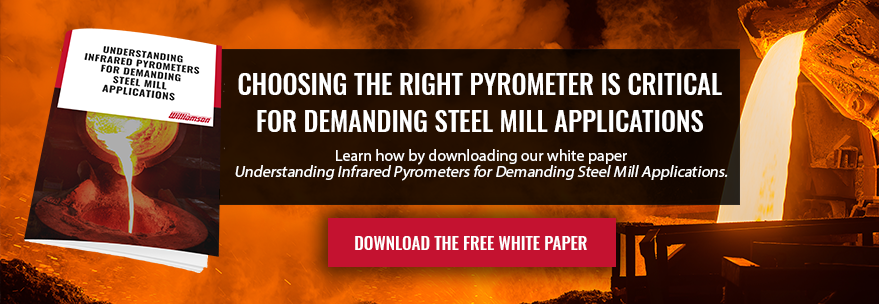
Foundry/Melt Shop
At the foundry/melt shop molten steel is poured from ladles into a tundish where it flows through a caster mold, forming a thin slab. The cooled mold creates a thin, solid wall on the slab.
1. Ladle Pre-Heat Refractory:
Effective refractory preheat temperature control is important for energy efficiency and safety. Thermocouple based process control has proven to be a dangerous, inaccurate and costly approach. Non-contact temperature monitoring allows for direct control which helps preserve the shelf-life of the refractory and minimizes energy costs.
2. Caster Exit
The casted steel slab is sprayed with water to continue the solidification process. The temperature of the steel as it cools is a critical process parameter. Controlled steel temperature in the caster zones eliminates cracking and bulging and allows for the optimization of caster speed.
Hot Rolling Mill
 The hot rolling mill reheats shapes of steel to soften them so they can be rolled thinner and longer through a series of rolling stands. The finished product can be a strip, plate, rod, bar, wire, or shape (rails and H-beams). After the steel is formed to shape, it is then cooled so that the desired mechanical properties of the steel product are achieved. Temperature control is critical throughout the Hot Rolling Mill to yield the desired product properties, ensure quality product, and improve line speed.
The hot rolling mill reheats shapes of steel to soften them so they can be rolled thinner and longer through a series of rolling stands. The finished product can be a strip, plate, rod, bar, wire, or shape (rails and H-beams). After the steel is formed to shape, it is then cooled so that the desired mechanical properties of the steel product are achieved. Temperature control is critical throughout the Hot Rolling Mill to yield the desired product properties, ensure quality product, and improve line speed.
1. Reheat Furnace Entry & Exit:
The reheat furnace control system must adjust to the temperature, mass and distribution of the incoming steel. Over-heating the steel wastes energy, limits the rolling speed, and adversely affects the properties of the steel. Under-heating the steel also affects steel properties and risks damage to the rolls.
2. Rollings Stands
Temperature readings at the rolling stands provide important feedback for the reheat furnace and helpsmaintain product quality. An accurate temperature reading is essential to optimally adjust line speed and assure desired steel properties. Temperature consistency between the top and bottom of the rolled steel also prevents derailment.
3. Quench Zone
The cooling rate through the laminar quench zone is a critical factor affecting the physical properties of the product, particularly for high tensile strength and dual phase steel alloys. Accurately monitoring the cooling rate assures the right crystal structure and hardness of the steel.
4. Coiler
Steel temperature at the coiler has a significant impact on product properties. Coiler temperature is critical to confirm desired mechanical properties. By accurately monitoring temperature, you can also prevent over-cooling and conserve energy costs.
5. Cooling Zone
The rate at which the steel is cooled and the final temperature at the exit of the cooling bed is critical to confirm desired mechanical properties. By accurately monitoring temperature, you can also prevent over-cooling and conserve energy costs.
Annealing/Finishing Mill
In the annealing process, a controlled time-temperature relationship is important to obtain the desired mechanical properties of the steel strip. Temperature variations can result in unacceptable mechanical properties, while side-to-side or top-to-bottom temperature gradients can cause product inconsistencies. Non-uniform strip temperatures also adversely impact quality requirements downstream.

1. Cold Rolling Mill
At the cold mill it is important that the steel does not get too hot. Overheating steel as it is rolled affects the mechanical and dimensional properties of the steel and causes surface blemishes.
2. Welder
The trailing edge of one coil is welded to the leading edge of the next to allow the strip to be fed continuously through the coating or annealing line. A weld break stops production for an extended time. Therefore, assuring a quality weld is an important safeguard to assure high productivity. Current anomalies, pressure variance, impurities, misalignment and other weld inconsistencies all manifest themselves as a temperature variation. As a result, weld temperature is commonly used as a go / no-go indicator at the welder.
3. General Strip Temperature
The temperature of steel in the continuous annealing line determines the customer desired mechanical properties. Strip measurements can and should be made throughout the heating, soaking, cooling and snout zones either by using a direct view or roller wedge technique. The strip can be measured in air and at the zinc/galvanneal/galvalume coating furnace entries and exit.
4. Coated Strip
Various coatings, including: dry lube, oil, clear acrylic, primer and a wide range of opaque coatings, are applied to the steel strip in order to protect the metal providing value-added benefits to consumers. Temperature control at the paint line is needed to ensure proper adhesion of the paint to the steel. Additionally, accurate temperature measurement assures consistent product color and curing speed.
Temperature control in the steel mill plays a critical role in determining the final physical properties and quality of the steel product. Monitoring temperature at the correct locations will help reduce energy consumption and waste while optimizing quality and productivity. Download our white paper, Understanding Infrared Pyrometers for Demanding Steel Mill Applications to learn more and please do not hesitate to reach out with any questions.

